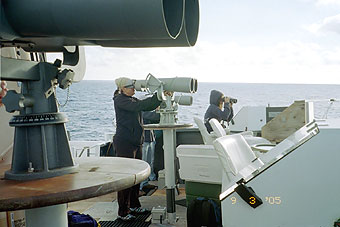

 | |||||||
|
|
Journals 2005/2006Maureen Barrett
September 3, 2005 Three different times today we were joined by ocean dolphins. Dolphins belong to the family Delphinidae, the largest cetacean family. There are over thirty species of delphinids, and today we saw two of them: the short-beaked common dolphin (Delphinus delphis) and the striped dolphin (Stenella coeruleoalba). The first group of dolphins sighted was all short-beaked common dolphins. This group appeared soon after sunrise. The second sighting consisted mostly of short-beaked common dolphins with a couple of striped dolphins mixed in. I was able to get a good look at one of the striped dolphins to see the difference between the two species. Before this trip, I never had the opportunity to get a close look at dolphins in the wild. Occasionally, I'll see dolphins off the coast of New Jersey from the beach but without binoculars in hand. So actually seeing their field marks was a real treat. It took was us about forty minutes to catch up with the third dolphin sighting before they decided to join us for some bow and wake riding. This group had more of a balance of the two species. There were still more commons in the group, but the percentage of striped dolphins was considerably higher than in the second sighting. Like yesterday, there were hundreds of them. There were times some of them lined up in a long row and porpoised all at the same time. What an incredible display of timing! The dolphins jumped and played like they were children on a playground. Some of their jumps reached about ten feet in height. I watched one dolphin come out of the water belly up and do a back dive. They really seemed to be enjoying themselves as they twisted and turned their bodies in mid air and then slapped themselves on the water. After about an hour of play, it was time for us to go our separate ways.
The primary objective of CSCAPE is to survey the cetaceans in this ecosystem. After each sighting, all of the mammal observers have to record three numbers for each species seen: a best estimate, a high, and a low. The best estimate is just that - the observers best estimate of how many individuals they think were present. The low number represents the lowest number that could have been present, and the high represents their estimate for the highest possible number of individuals in the group. With most of the whale sightings, this has been relatively easy. However, determining a number for such a large group of dolphins must be extremely difficult. The dolphins are not all surfacing at the same time, swimming in the same direction, or all in the same area. And to top it off, the observers cannot discuss their numbers with each other. Each observer must independently record his/her estimates. A helicopter would really come in handy on days like today! Aerial photos may make the job of counting the cetaceans a little easier. Actually, the David Starr Jordan has the capacity for the addition of a helicopter pad. A McDonald Douglas 500D helicopter was used on this ship from 1988 to 2003 for the eastern tropical Pacific cetacean studies, but it hasn't been used since. Today, many surveys are conducted using aerial photography, but this CSCAPE project involves only shipboard surveys. |
||||||
